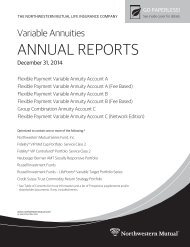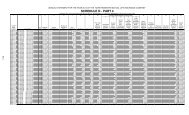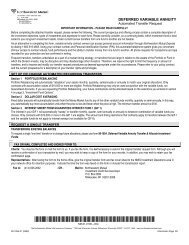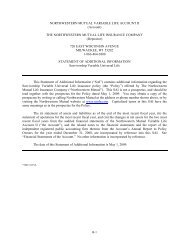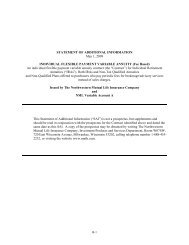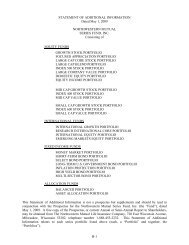par unless the price of the underlying instrument has fallen below a certain “break point,” in which casethe note holder receives a proportionate amount of units or shares of the underlying instrument.In addition to the risks relating to fixed income securities generally, reverse convertible notes aresubject to similar risks as those of the equity securities to which they are linked, such as the risk that theprice of the related security may fall, causing the value of the note to drop. Further, reverse convertiblenotes do not have the same appreciation potential as the underlying equity securities (usually commonstocks) to which they are linked because, at maturity, the value of the note will not appreciate above theinitial principal amount plus the stated coupon rate. Because a Portfolio may deliver the underlyingsecurity prior to note maturity, a Portfolio investing in reverse convertible notes has the potential forprincipal loss as reverse convertible notes are not principal-protected. Reverse convertible notes are notexchange traded, and the secondary market may be illiquid, making them illiquid and increasing thePortfolio’s reliance on the issuer’s ability to meet its obligations to make payments of principal andinterest.WarrantsEach of the Portfolios may invest in warrants. Warrants are instruments which entitle the holderto buy an equity security at a specific price for a specific period of time. Changes in the value of awarrant do not necessarily correspond to changes in the value of its underlying security. The price of awarrant may be more volatile than the price of its underlying security, and a warrant may offer greaterpotential for capital appreciation as well as capital loss. Warrants do not entitle a holder to dividends orvoting rights with respect to the underlying security and do not represent any rights in the assets of theissuing company. A warrant ceases to have value if it is not exercised prior to its expiration date. Thesefactors can make warrants more speculative than other types of investments.High Yield, High Risk BondsEach of the Portfolios, except the Money Market Portfolio, may invest in high yield, high riskbonds, commonly referred to as “junk” bonds. The total return and yield of junk bonds can be expected tofluctuate more than the total return and yield of higher quality, shorter term bonds, but is not as much asthose of common stocks. Junk bonds are regarded as predominantly speculative with respect to theissuer’s continuing ability to meet principal and interest payments.Auction Rate SecuritiesEach Portfolio, other than the Money Market Portfolio, may invest in auction rate securities inaccordance with its investment objectives and strategies and in accordance with the 1940 Act. An auctionrate security is one in which the interest rate or dividend rate, depending on the type of security beingauctioned, is initially determined, and subsequently reset, through a Dutch Auction process.Typically, in a Dutch Auction, a broker-dealer submits bids on behalf of current and prospectiveinvestors to the auction agent. Each bid represents the number of shares or par that an investor is lookingto purchase, along with the lowest interest rate or dividend rate they are willing to accept in return. Thelowest bid rate at which all the shares can be sold at par establishes the auction rate, otherwise known asthe "clearing rate". This rate is paid on the entire issue for the upcoming period. Investors who bid aminimum rate above the clearing rate receive no securities, while those whose minimum bid rates were ator below the clearing rate receive the clearing rate for the next period. This type of auction market,generally, allows issuers access to low-cost financing while providing buyers of auction rate securitieswith the potential to earn higher yields on their short-term investments.Auctions are held on a regular basis, typically weekly, monthly, quarterly, or some versionthereof, and will only take place if there are enough orders to purchase all securities being sold at theauction. Depending on the type of market or security at auction, the holder of an auction rate securitygenerally has the ability to submit any one of the following orders:B-34
• Hold - Hold an existing position regardless of the new clearing rate (these securities are notincluded in auction).• Hold at Rate/Roll - Bid to hold an existing position at a specified minimum rate. If the clearingrate is below the bid to hold rate, the securities are sold.• Sell - Sell an existing position regardless of the clearing rate set at the auction.• Buy - Submit a bid to buy a new position at a specified minimum clearing rate (new buyers orexisting holders adding to their position at a specified interest rate).In the event there are not enough buyers for a specific auction, the auction agent will determinethat the auction has “failed”. In a failed auction the clearing rate for all securities automatically resets tothe maximum rate defined in the offering documents of the issuer (primarily to compensate those whocould not sell their positions because of the failed auction), until the next successful auction. Althoughthey are not required to do so, broker-dealers may enter purchase bids on their own behalf to assist inpreventing a failed auction.There also may be an auction where all existing holders of auction rate securities submit holdorders as described above. In such a scenario, the auction agent will determine that an “All Hold” auctionhas taken place, and the clearing rate for all securities automatically resets to the All Hold Rate as definedin the offering documents of the issuer, until the next auction. This rate tends to be less than the currentmarket rate an investor could receive had they invested in a similar security outside of the auction ratemarket.The primary risk of investing in the auction rate securities market is liquidity risk. In the event ofa failed auction, a Portfolio may not be able to sell a position when desired, and may need to continue tohold the position due to the lack of an efficient secondary market until the next successful auction or thelegal maturity. A secondary risk of investing in auction rate securities, similar to investing in other typesof fixed income securities, is the credit risk of the issuer.Inflation-Indexed BondsThe Portfolios may purchase inflation-linked securities issued by the U.S. Treasury, U.S.government agencies and instrumentalities other than the U.S. Treasury, and entities other than the U.S.Treasury or U.S. government agencies an instrumentalities. Inflation-indexed bonds are debt instrumentswhose principal value is adjusted periodically according to a rate of inflation (usually a consumer priceindex). Two structures are most common. The U.S. Treasury and some other issuers use a structure thataccrues inflation into the principal value of the bond. Most other issuers pay out the inflation accruals aspart of the semiannual coupon.Inflation-linked securities are designed to offer a return linked to inflation, thereby protectingfuture purchasing power of the money invested in them. However, inflation-linked securities provide thisprotected return only if held to maturity. In addition, inflation-linked securities may not trade at parvalue. Real interest rates (the market rate of interest less the anticipated rate of inflation) change overtime as a result of many factors, such as what investors are demanding as a true value for money. Whenreal rates do change, inflation-linked securities prices will be more sensitive to these changes thanconventional bonds, because these securities were sold originally based upon a real interest rate that is nolonger prevailing. Should market expectations for real interest rates rise, the price of inflation-linkedsecurities and the share price of a Portfolio holding these securities will fall. Investors in the Portfoliosshould be prepared to accept not only this share price volatility but also the possible adverse taxconsequences it may cause.An investment in securities featuring inflation-adjusted principal and/or interest involves factorsnot associated with more traditional fixed principal securities. Such factors include the possibility that theinflation index may be subject to significant changes, those changes in the index may or may not correlateB-35
- Page 4: APPENDIX F - Proxy Voting Policies
- Page 9 and 10: stocks that make up that index. Str
- Page 11 and 12: Interest rate swaps do not involve
- Page 13 and 14: the Adviser or Sub-Adviser will not
- Page 17 and 18: Forward Contracts. The Portfolios m
- Page 19 and 20: principal amount as the call writte
- Page 21 and 22: Options on Foreign Currencies. The
- Page 23 and 24: securities. The issuers of the unde
- Page 25 and 26: the former pools. However, timely p
- Page 27 and 28: CMO residuals are generally purchas
- Page 29: utilize the underlying assets may r
- Page 32 and 33: include range floaters which are a
- Page 36 and 37: to changes in interest rates genera
- Page 38 and 39: corresponding floaters. The underly
- Page 40 and 41: A Portfolio will not enter into suc
- Page 42 and 43: egulations. The presence of an issu
- Page 44 and 45: Portfolio TurnoverPortfolio turnove
- Page 46 and 47: The ability of the Portfolio to ach
- Page 48 and 49: Advisors, LLC, in accordance with t
- Page 50 and 51: OWNERSHIP OF SHARES OF THE FUNDAll
- Page 52 and 53: on the next $50 million, 0.50% on t
- Page 54 and 55: Independent Registered Public Accou
- Page 56 and 57: Name of Portfolio 2008 2007 2006Int
- Page 58 and 59: Broker High Yield Bond BalancedAsse
- Page 60 and 61: and cost of trade execution of Port
- Page 62 and 63: Effective April 30, 2008, the Fund
- Page 64 and 65: TAXES AND DIVIDENDSEach Portfolio i
- Page 66 and 67: APPENDIX A - Credit RatingsDescript
- Page 68 and 69: F2Good credit quality. A satisfacto
- Page 70 and 71: . Moody’s Commercial Paper (short
- Page 72 and 73: Plus (+) or minus (-)The ratings fr
- Page 74 and 75: APPENDIX B - Directors and Officers
- Page 76 and 77: Name, Address, andYear of BirthDavi
- Page 78 and 79: APPENDIX C - Ownership of Shares of
- Page 80 and 81: SMALL CAP VALUE PORTFOLIOGeneral Ac
- Page 82 and 83: APPENDIX D - Portfolio ManagersOthe
- Page 84 and 85:
PortfolioManager(s)FundRegisteredIn
- Page 86 and 87:
Compensation of Portfolio ManagersM
- Page 88 and 89:
management firms. Performance is pr
- Page 90 and 91:
Portfolio managers are eligible for
- Page 92 and 93:
PortfolioPortfolio Manager(s)Dollar
- Page 94 and 95:
On August 25, 2005, the Court enter
- Page 96 and 97:
MSA’s Equity Trading Department s
- Page 98 and 99:
ERISA ClientsIn the case of client
- Page 100 and 101:
Shareholder Ability to Call Special
- Page 102 and 103:
• Exercise price• Participation
- Page 104 and 105:
Amend Quorum RequirementsVote propo
- Page 106 and 107:
Vote proposals to increase blank ch
- Page 108 and 109:
employees of Investment Manager and
- Page 110 and 111:
will not support the position of a
- Page 112 and 113:
company specifies the voting, divid
- Page 114 and 115:
egarding whether Investment Manager
- Page 116 and 117:
3. The issuer is an entity particip
- Page 118 and 119:
manager(s) are responsible for maki
- Page 120 and 121:
Global Corporate Governance: Invest
- Page 122 and 123:
13. The Proxy Group will review the
- Page 124 and 125:
determined by those investment comm
- Page 126 and 127:
T. Rowe Price has adopted these Pro
- Page 128 and 129:
shareholders and the effect on shar
- Page 130 and 131:
portfolio company could have influe
- Page 132 and 133:
The Proxy Voting Service will refer
- Page 134 and 135:
that substantially differs from dom
- Page 136 and 137:
15. Janus will generally vote in fa
- Page 138 and 139:
46. For shareholder proposals outsi
- Page 140 and 141:
2. Staggered BoardIf a company has
- Page 142 and 143:
proposed for a legitimate business
- Page 144 and 145:
APPENDIX G - Portfolio Holdings Dis
- Page 146:
ICP Securities LLCIntermonte Securi



